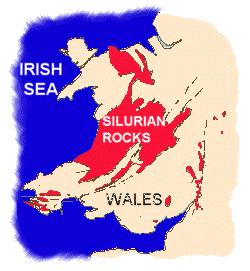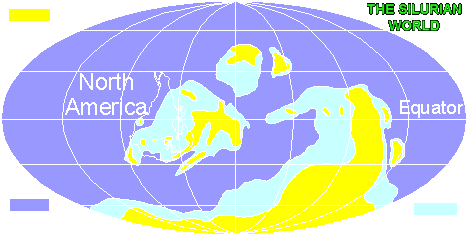 The Silurian can be defined as a period of geologic time between 408 and 438 million years ago that was preceded by the Ordovician Period and followed by the Devonian Period. The Silurian can be defined as a period of geologic time between 408 and 438 million years ago that was preceded by the Ordovician Period and followed by the Devonian Period.
 The term Silurian comes from Silures, the name of a tribe of people that lived along the border of England and Wales before the time of the Romans. In the early 1800s, British geologists recognized rocks in this area that contained a distinctive assemblage of fossils, different from the fossils in both underlying (or older) strata and overlying (or younger) strata. "Silurian" was applied to the period of time represented by this fossil assemblage. The term Silurian comes from Silures, the name of a tribe of people that lived along the border of England and Wales before the time of the Romans. In the early 1800s, British geologists recognized rocks in this area that contained a distinctive assemblage of fossils, different from the fossils in both underlying (or older) strata and overlying (or younger) strata. "Silurian" was applied to the period of time represented by this fossil assemblage.
 Silurian fossils, identical to those in Britain, were subsequently discovered in many other regions of the world, including the Great Lakes region of North America. Pictures on the left show Silurian fossils from Britain, and pictures on the right show Silurian fossils from Wisconsin. The pictures are arranged to show the close similarity in marine faunas of these areas. Silurian fossils, identical to those in Britain, were subsequently discovered in many other regions of the world, including the Great Lakes region of North America. Pictures on the left show Silurian fossils from Britain, and pictures on the right show Silurian fossils from Wisconsin. The pictures are arranged to show the close similarity in marine faunas of these areas.

 The Silurian world was vastly different in many ways than the world of today. The shapes and distribution of the continents was not the same as now, and shallow seas covered much of the continental areas. For example, the equator passed through North America, and a nearly continuous inland sea stretched between New York and Nevada. Although the Silurian seas were populated by a variety of marine life, the land was inhabited only by a few types of small plants and tiny bugs. The Silurian world was vastly different in many ways than the world of today. The shapes and distribution of the continents was not the same as now, and shallow seas covered much of the continental areas. For example, the equator passed through North America, and a nearly continuous inland sea stretched between New York and Nevada. Although the Silurian seas were populated by a variety of marine life, the land was inhabited only by a few types of small plants and tiny bugs.
|















